- Data Calling
- Posts
- When It Comes To Energy...It's Complicated
When It Comes To Energy...It's Complicated
The Musk/Trump breakup showed how American views on energy are a bit nuanced


With the Trump/Musk breakup moving on to the next stage (fine I am starting my own party) the news continues to keep getting sillier. However, this breakup has allowed us to get an interesting view into where Americans land on a handful of issues. As discussed earlier, on deficits Americans are more on Musk’s side. On taxes it is a mixed bag, and more Americans believe that Trump would have lost if it wasn’t for Musk.
The other issue that was front and center in the original breakup was energy. Musk is more on the side of renewables being where the future lies, while Trump is a proud card carrying member of the Drill Baby Drill fraternity. The “Big Beautiful Bill” took this a step further, not only favoring fossil fuels, but to punishing renewable sourcing as well (the data in this piece was collected prior to the BBB being passed). As has been the case with the issues that the breakup has focused on, we wanted to see where Americans agree or disagree with the two main characters regardless of how they view each individual personally.
For energy issues we asked two questions: do you agree or disagree with the idea that renewables are the energy of the future, and whether the United States needs to keep expanding the places where we can drill for oil. We asked for their reaction to both ideas to see not just how Americans felt about the two positions being staked out, but also how many people agree or disagreed with both.
While this issue difference between Musk and Trump was arguably a second tier disagreement of the fight, it is where there is much more nuance in how American’s view the issue of energy, especially when compared to economic issues, which are more black and white.
Are Renewables the Energy of the Future?
Overall, a majority of Americans (52%) agree that renewable fuels are the energy source of the future. This includes a third of Americans who feel this way strongly. Just 22% disagree with the idea, while a quarter are more in the “meh” category.
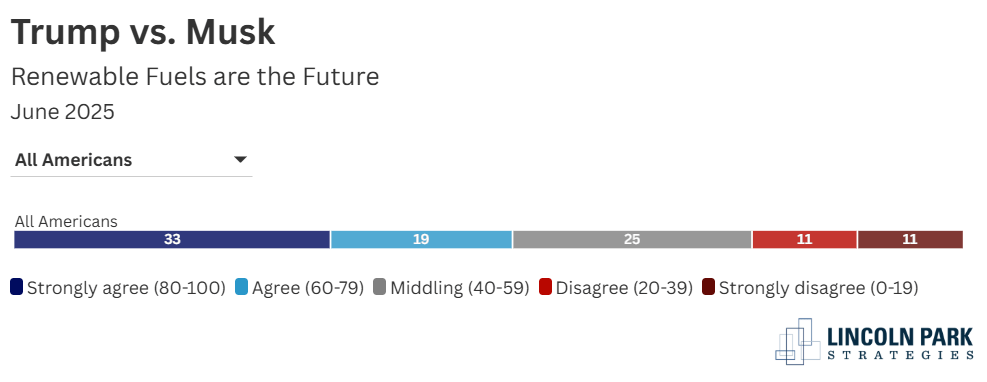
Some demographic groups have predictable differences. For example, younger Americans are more likely to agree that renewables are the future. What is interesting is that GenZ has the lowest concentration of those who feel this strongly (and the highest concentration of those who are more indifferent). Millennials are the most likely to agree (58%) while Boomers are the mostly likely to disagree (30%).
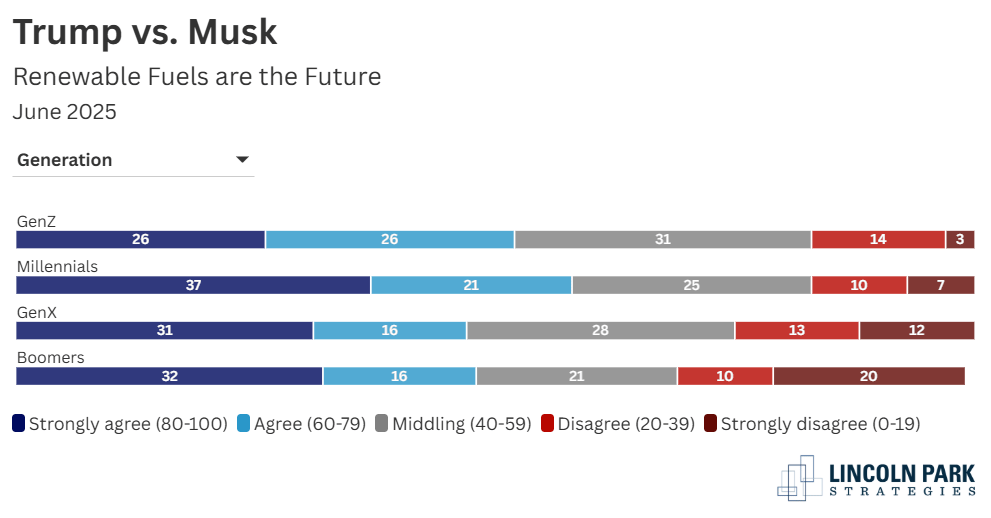
Not shockingly Trump voters are less likely to agree that renewables are the future than Harris voters. That being said, almost half of Trump voters (48%), agree that this is where we are heading on energy, while just 30% disagree. This pales in comparison to where Harris voters are, but is still a significant difference, and certainly another issue where Republicans are more on Team Musk than Team Trump.
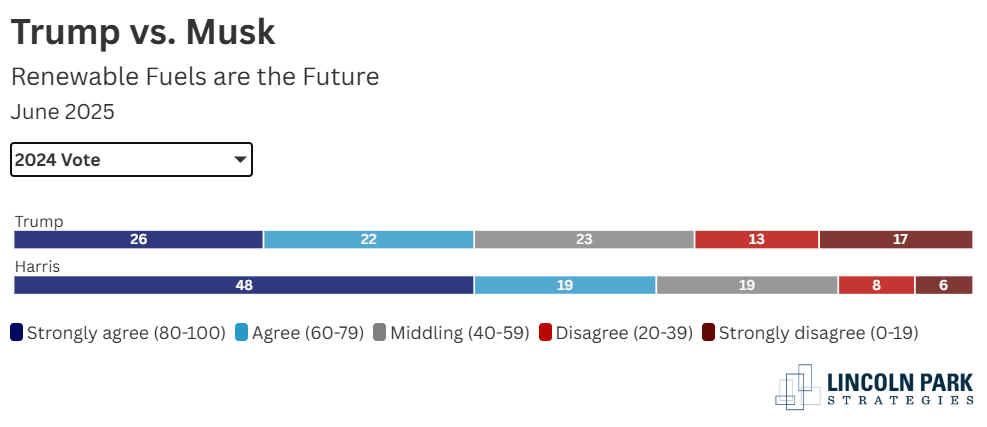
Given these numbers it is interesting to see the breakdown by political state status. Americans in Blue States are the most likely to agree on renewables (57%), and while this is not shocking, the fact that voters in Red States are not far behind (50%) and agree more than Swing State voters (44%) is a bit of a surprise.
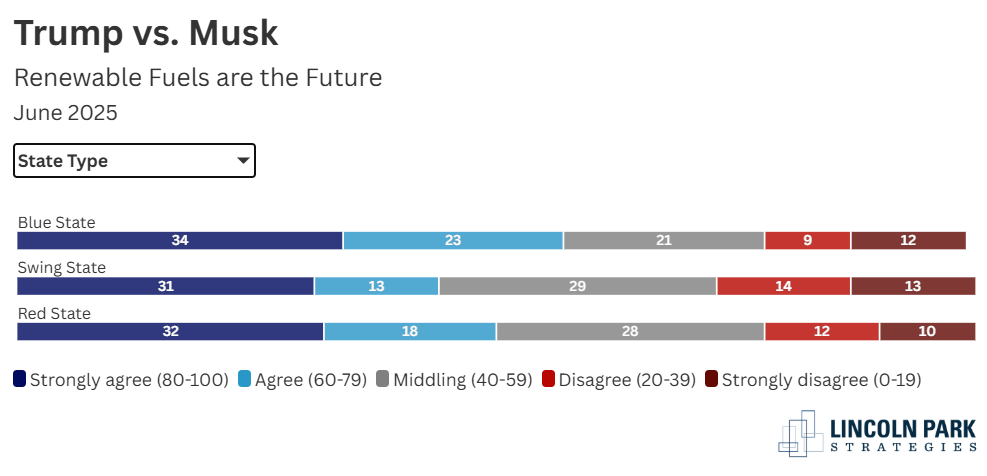
Another surprise is when we look at gender and education. On economic issues, college educated men tended to share Trump’s world view much more than Musk’s especially on Tariffs and taxes. However on renewable energy, this cohort has the highest concentration of those who agree on the importance of these sources with nearly two-thirds (65%) agreeing that this is the direction we are heading. College educated women are not far behind in this belief (62% agree), while pluralities of Americans who do not have a college degree also feel this way.
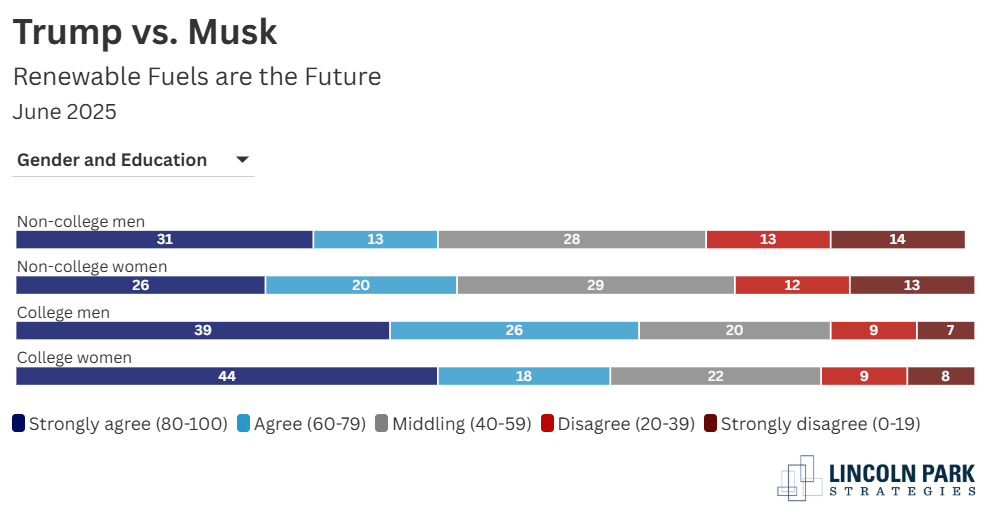
Drill Baby Drill
While a majority of Americans agree on the future of our energy sources, this does not necessarily mean that Trump’s view of drill now, drill everywhere is a complete non-starter. Overall, 41% of Americans agree that we should be expanding our drilling, while 33% disagree.
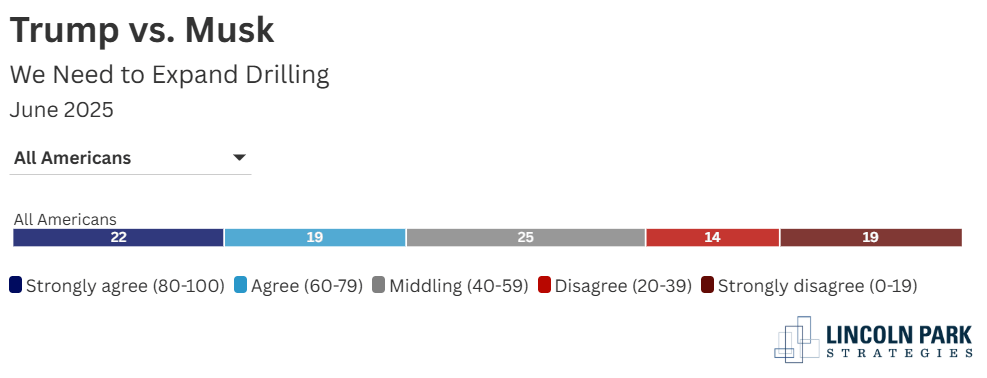
Not shockingly, there are big divides on this question when it comes to the two political parties. Two-thirds of Trump voters (67%) agree that we need to expand drilling, while just 15% disagree. Harris voters are much more likely to disagree (49%), however just over a quarter (26%) agree that we need to drill more.
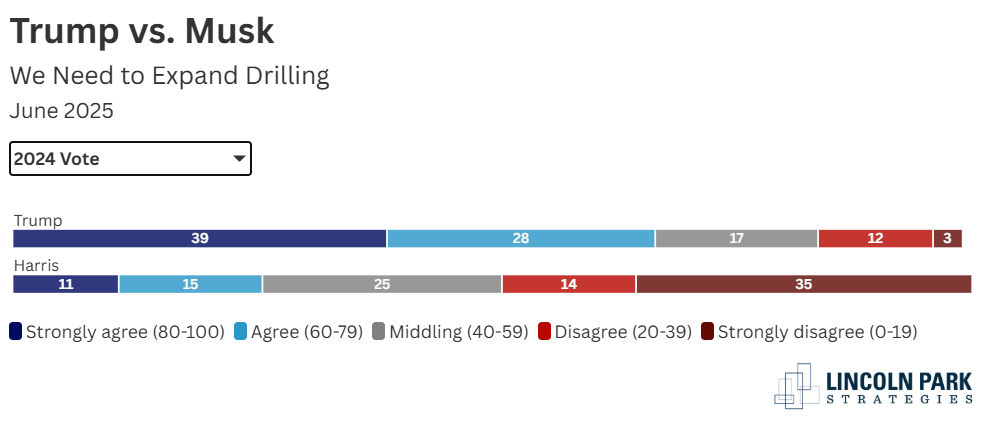
This leads to some interesting results when we break the results down by the type of state that Americans live in. Red State residents (not surprisingly) are the most supportive of drilling more, but it is not a majority of residents. Forty-four (44) percent of Red State inhabitants agree that we should be drilling more, while 31% disagree. In Swing States, the concentration of those who feel there should be more drilling is not far behind (39%) while those disagreeing is higher (38%). Blue Staters have an equal concentration of those who support more drilling as Swing States, but a lower concentration of those opposed (32% opposed in Blue States).
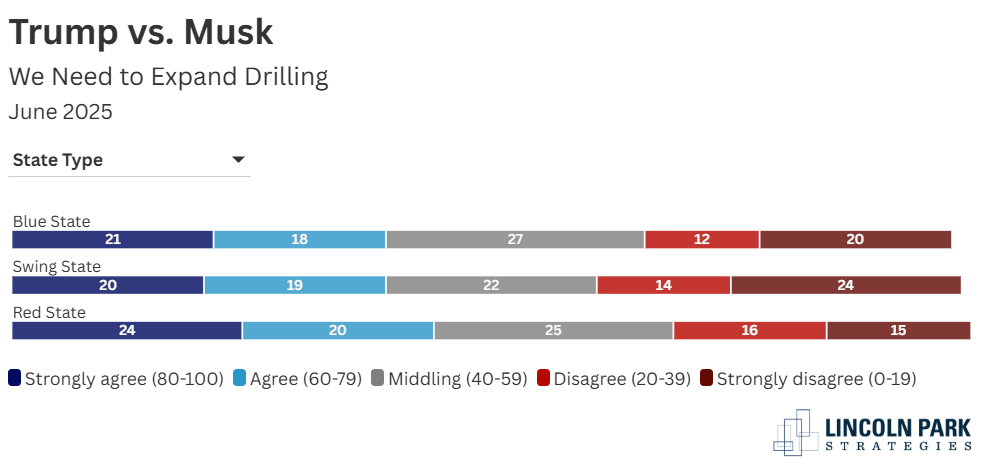
Looking at different age groups GenZ Americans are the lest supportive of expanding drilling. This is generally not shocking, but the differences between the next three generations is minimal, which is a bit surprising. Just over a quarter of GenZ (28%) agrees that we need to expand drilling, while 40% disagree. For Millennials, support increases to 42% which is similar to GenX (43%) and Boomers (46%).
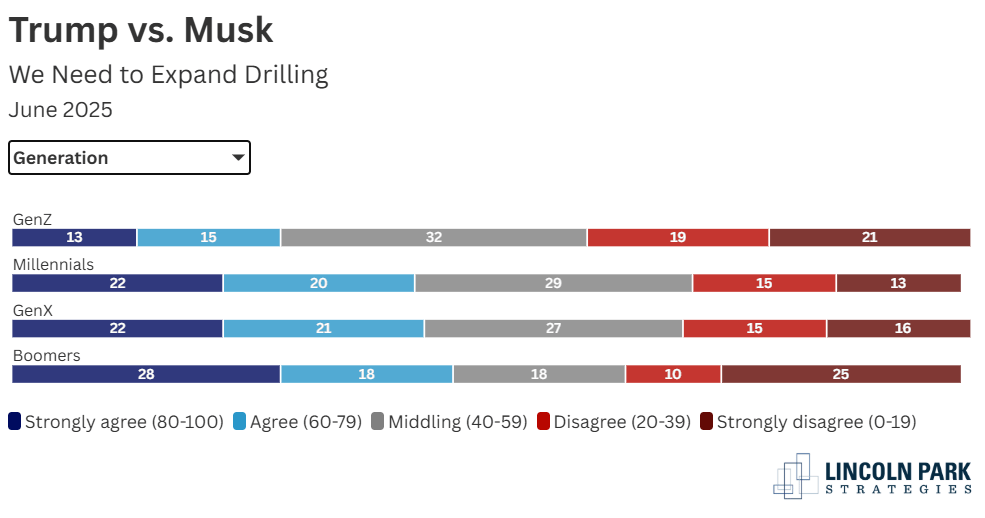
As mentioned above, men with a college degree were the biggest supporters of the idea that renewables are the future for energy. At the same time, they are also have the highest concentration of those who feel we should be expanding our drilling efforts. Women with a college degree, and those without a degree, regardless of gender, are less supportive overall and are more evenly divided in terms of those who agree and disagree.
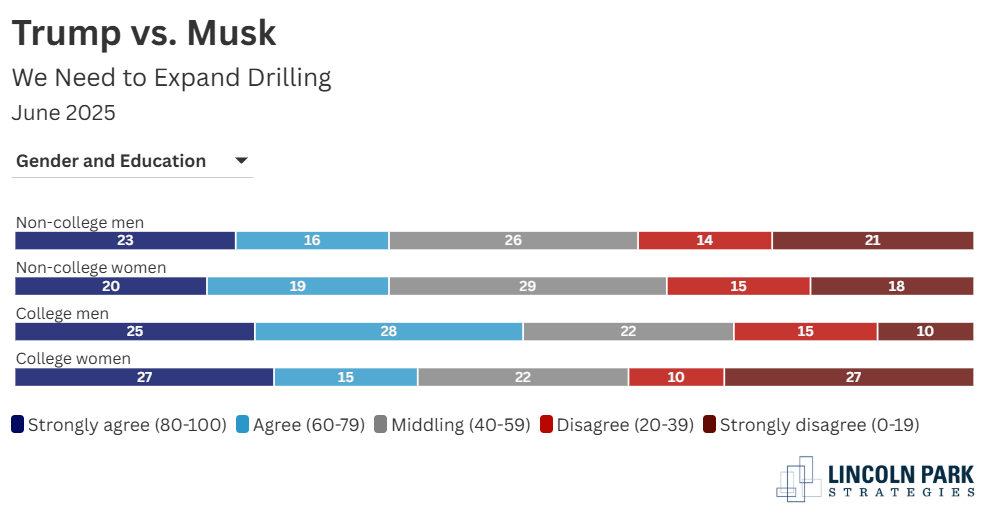
Putting It All Together
In general, we tend to think of issues in very black and white terms. You are either for X or for Y. The reality is that many people are somewhere in the middle of the two binary choices. Renewables and drilling are a perfect example of this fact. The way the issue is generally presented you either support drilling or you support moving to renewables. The largest group of American (25%) agree with both. Sixteen (16) percent fall into the more conventional view of strongly supporting renewables and disapproving of more drilling. An additional 11% are generally supportive of renewables and oppose drilling, while 18% are indifferent on the idea of renewables being the future while also being opposed to more drilling.

Put together these three groups equal 45% of the population. On the flipside 9% are strongly supportive of more drilling and opposed to the idea of renewables being the future. An additional 8% are reasonably supportive of more drilling, and 5% are indifferent on drilling, but oppose the idea of renewables being the fuel of the future.
While the individual questions have some interesting demographic differences, the combination of the two are arguably more intriguing. When looking at the type of state people live in, the results are somewhat expected in that the highest concentration of those who are more on the side of the renewables end of the spectrum are the largest in Blue States, and smallest in Red States. That being said, the difference between the three categories is incredibly small. In Blue States, 47% fall into one of the green categories compared to 44% of Swing State residents, and 42% of Red State. Swing States have the smallest concentration of those who agree with both concepts, and also have the highest concentration of those who disagree with both (contrarians are everywhere).
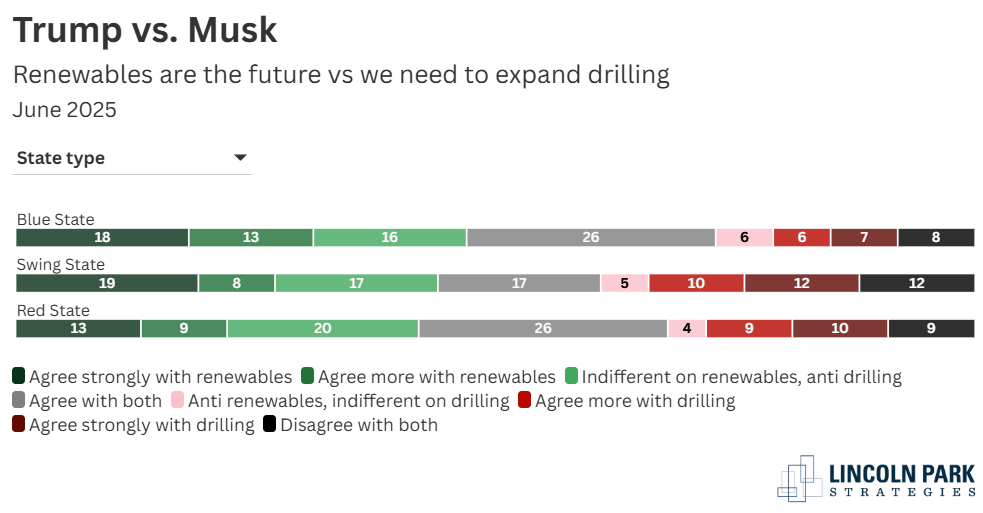
Looking at how people voted in 2024 the results are more predictable in the big picture. Overall Harris voters are much more supportive of renewables than they are of drilling. No real surprise there. What is surprising is how few of Trump supporters are on the more exclusive side of supporting drilling. Overall, 37% of Trump voters are in the Drill Baby Drill camp. This is larger than those who are more supportive of Musk’s view of supporting renewables (22%) and also slightly larger than those who agree with both points of view (35%). This puts the cohort in the odd place of 72% of his voters supporting the position of more drilling, and 57% agreeing the renewables are the future.
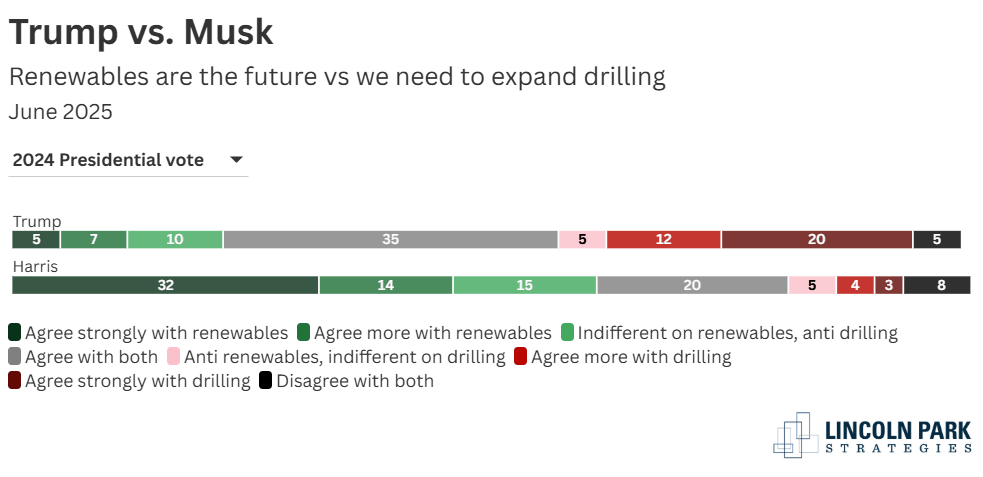
For Harris voters, support for renewables far outweighs the openness to more drilling but it is certainly not a 100 to 0 divide. Overall, 61% of Harris voters fall somewhere on the supportive of renewables and opposing drilling spectrum. On the opposite end 12% are in the pro-drilling side of the equation, while 8% oppose both. Interestingly 1 in 5 Harris voters support both positions.
Given the more nuanced views on the issue of energy and renewables it is unlikely that either side in this messy fight is going to win a knockout punch. If Musk is able to get his political party off the ground it will be interesting to see if he makes these issues a central part of the messaging or not. On the one hand it is unlikely to be effective if presented as a renewables only position. On the other hand, pointing out that Trump is only sitting on one side of the fence could be an effective approach.
Check out the interactive charts on our website
What Happens Next is out
Every month our Founder and President gets together with Justin Wallin of J Wallin Research and Charles Ellison of the BE Note to discuss the big issues of the day. We certainly don’t agree on everything, but we can have a discussion. The next episode is being recorded next week.
Check it out, share, and subscribe (as they say)